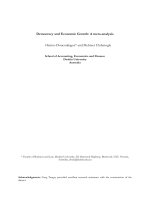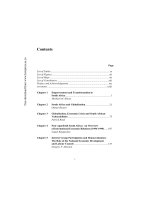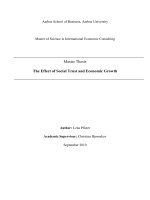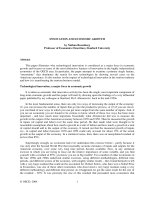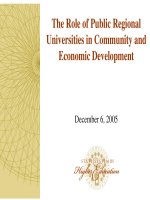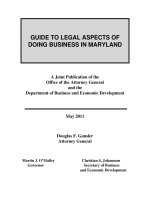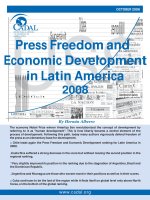Work, Female Empowerment and Economic Development pdf
Bạn đang xem bản rút gọn của tài liệu. Xem và tải ngay bản đầy đủ của tài liệu tại đây (1.44 MB, 252 trang )
Work, Female Empowerment and
Economic Development
Accumulation of assets to enable the diversification of activities has been estab
-
lished as crucial in helping the rural poor escape poverty. The empowerment of
women has been identified as a way to overcome inefficiencies in the allocation of
resources within the family and so improve agrarian households’ productivity.
However, achieving diversification is not necessarily empowering for women and
some initiatives may worsen their position.
This book uses the information collected in original household surveys
conducted in rural areas in four countries to investigate the links between women’s
position in the household, diversification strategies, labour market participation
and poverty reduction. The book centres on country-specific chapters that provide
an in-depth focus on an issue of relevance to the location and that tease out the
interplay between female empowerment and development in that context. In
particular, the chapters examine:
•
Landlessness in Ethiopia
•
Feminization of the agricultural labour market in Andhra Pradesh, India
•
Female labour supply and women’s power within the household in Uganda
•
Disadvantages faced by female-headed households in Zimbabwe
The analysis calls for caution in assuming that labour market expansion neces
-
sarily acts to empower women and emphasizes the role female access to assets can
have in facilitating diversification and escaping poverty. It will appeal to all those
studying development economics, with particular interest in areas such as diversi
-
fication, poverty and female empowerment.
Sara Horrell is a Senior Lecturer in Economics at the University of Cambridge
and a Fellow of New Hall, Cambridge.
Hazel Johnson is Professor of Development Policy and Practice at The Open
University.
Paul Mosley is Professor of Economics at the University of Sheffield.
Routledge Studies in Development Economics
1 Economic Development in the
Middle East
Rodney Wilson
2 Monetary and Financial Policies
in Developing Countries
Growth and stabilization
Akhtar Hossain and
Anis Chowdhury
3 New Directions in Development
Economics
Growth, environmental concerns
and government in the 1990s
Edited by Mats Lundahl and
Benno J. Ndulu
4 Financial Liberalization and
Investment
Kanhaya L. Gupta and
Robert Lensink
5 Liberalization in the Developing
World
Institutional and economic
changes in Latin America, Africa
and Asia
Edited by Alex E. Fernández
Jilberto and André Mommen
6 Financial Development and
Economic Growth
Theory and experiences from
developing countries
Edited by Niels Hermes and
Robert Lensink
7 The South African Economy
Macroeconomic prospects for the
medium term
Finn Tarp and Peter Brixen
8 Public Sector Pay and
Adjustment
Lessons from five countries
Edited by Christopher Colclough
9 Europe and Economic Reform in
Africa
Structural adjustment and
economic diplomacy
Obed O. Mailafia
10 Post-apartheid Southern Africa
Economic challenges and policies
for the future
Edited by Lennart Petersson
11 Financial Integration and
Development
Liberalization and reform in sub-
Saharan Africa
Ernest Aryeetey and
Machiko Nissanke
12 Regionalization and
Globalization in the Modern
World Economy
Perspectives on the Third World
and transitional economies
Edited by Alex E. Fernández
Jilberto and André Mommen
13 The African Economy
Policy, institutions and the future
Steve Kayizzi-Mugerwa
14 Recovery from Armed Conflict
in Developing Countries
Edited by Geoff Harris
15 Small Enterprises and Economic
Development
The dynamics of micro and small
enterprises
Carl Liedholm and
Donald C. Mead
16 The World Bank
New agendas in a changing world
Michelle Miller-Adams
17 Development Policy in the
Twenty-First Century
Beyond the post-Washington
consensus
Edited by Ben Fine, Costas
Lapavitsas and Jonathan Pincus
18 State-Owned Enterprises in the
Middle East and North Africa
Privatization, performance and
reform
Edited by Merih Celasun
19 Finance and Competitiveness in
Developing Countries
Edited by José María Fanelli and
Rohinton Medhora
20 Contemporary Issues in
Development Economics
Edited by B.N. Ghosh
21 Mexico Beyond NAFTA
Edited by Martín Puchet Anyul and
Lionello F. Punzo
22 Economies in Transition
A guide to China, Cuba, Mongolia,
North Korea and Vietnam at the
turn of the twenty-first century
Ian Jeffries
23 Population, Economic Growth
and Agriculture in Less
Developed Countries
Nadia Cuffaro
24 From Crisis to Growth in
Africa?
Edited by Mats Lundal
25 The Macroeconomics of
Monetary Union
An analysis of the CFA franc zone
David Fielding
26 Endogenous Development
Networking, innovation,
institutions and cities
Antonio Vasquez-Barquero
27 Labour Relations in
Development
Edited by Alex E. Fernández
Jilberto and Marieke Riethof
28 The Crisis of Rural Poverty and
Hunger
An essay on the complementarity
between market and government-
led land reform for its resolution
M. Riad El-Ghonemy
28 Globalization, Marginalization
and Development
Edited by S. Mansoob Murshed
29 Programme Aid and
Development
Beyond conditionality
Howard White and Geske Dijkstra
30 Competitiveness Strategy in
Developing Countries
A manual for policy analysis
Edited by Ganeshan Wignaraja
31 The African Manufacturing
Firm
An analysis based on firm surveys
in sub-Saharan Africa
Dipak Mazumdar and
Ata Mazaheri
32 Trade Policy, Growth and
Poverty in Asian Developing
Countries
Edited by Kishor Sharma
33 International Competitiveness,
Investment and Finance
A case study of India
Edited by A. Ganesh Kumar,
Kunal Sen and Rajendra R. Vaidya
34 The Pattern of Aid Giving
The impact of good governance on
development assistance
Eric Neumayer
35 New International Poverty
Reduction Strategies
Edited by Jean-Pierre Cling,
Mireille Razafindrakoto and
François Roubaud
36 Targeting Development
Critical perspectives on the
Millennium Development Goals
Edited by Richard Black and
Howard White
37 Essays on Balance of Payments
Constrained Growth
Theory and evidence
Edited by J.S.L. McCombie and
A.P. Thirlwall
38 The Private Sector After
Communism
New entrepreneurial firms in
transition economies
Jan Winiecki, Vladimir Benacek
and Mihaly Laki
39 Information Technology and
Development
A new paradigm for delivering the
internet to rural areas in
developing countries
Jeffrey James
40 The Economics of Palestine
Economic policy and institutional
reform for a viable Palestine state
Edited by David Cobham and
Nu’man Kanafani
41 Development Dilemmas
The methods and political ethics of
growth policy
Melvin Ayogu and Don Ross
42 Rural Livelihoods and Poverty
Reduction Policies
Edited by Frank Ellis and
H. Ade Freeman
43 Beyond Market-Driven
Development
Drawing on the experience of Asia
and Latin America
Edited by Makoto Noguchi and
Costas Lapavitsas
44 The Political Economy of
Reform Failure
Edited by Mats Lundahl and
Michael L. Wyzan
45 Overcoming Inequality in Latin
America
Issues and challenges for the
twenty-first century
Edited by Ricardo Gottschalk and
Patricia Justino
46 Trade, Growth and Inequality in
the Era of Globalization
Edited by Kishor Sharma and
Oliver Morrissey
47 Microfinance
Perils and prospects
Edited by Jude L. Fernando
48 The IMF, World Bank and
Policy Reform
Edited by Alberto Paloni and
Maurizio Zanardi
49 Managing Development
Globalization, economic
restructuring and social policy
Edited by Junji Nakagawa
50 Who Gains from Free Trade?
Export-led growth, inequality and
poverty in Latin America
Edited by Rob Vos, Enrique
Ganuza, Samuel Morley, and
Sherman Robinson
51 Evolution of Markets and
Institutions
A study of an emerging economy
Murali Patibandla
52 The New Famines
Why famines exist in an era of
globalization
Edited by Stephen Devereux
53 Development Ethics at work
Explorations – 1960–2002
Denis Goulet
54 Law Reform in Developing and
Transitional States
Edited by Tim Lindsey
55 The Assymetries of
Globalization
Edited by Pan A. Yotopoulos and
Donato Romano
56 Ideas, Policies and Economic
Development in the Americas
Edited by Esteban Pérez-
Caldentey and Matias Vernengo
57 European Union Trade Politics
and Development
Everything but arms unravelled
Edited by Gerrit Faber and Jan
Orbie
58 Membership Based
Organizations of the Poor
Edited by Martha Chen, Renana
Jhabvala, Ravi Kanbur and Carol
Richards
59 The Politics of Aid Selectivity
Good governance criteria in World
Bank, U.S. and Dutch
development assistance
Wil Hout
60 Economic Development,
Education and Transnational
Corporations
Mark Hanson
61 Achieving Economic
Development in the Era of
Globalization
Shalendra Sharma
62 Sustainable Development and
Free Trade
Shawkat Alam
63 The Impact of International
Debt Relief
Geske Dijkstra
64 Europe’s Troubled Region
Economic development,
institutional reform and social
welfare in the Western Balkans
William Bartlett
65 Work, Female Empowerment
and Economic Development
Sara Horrell, Hazel Johnson and
Paul Mosley, with
Supriya Garikipati, June Rock
and Arjan Verschoor
Work, Female Empowerment
and Economic Development
Sara Horrell, Hazel Johnson
and Paul Mosley, with
Supriya Garikipati, June Rock
and Arjan Verschoor
First published 2008 by Routledge
2 Park Square, Milton Park, Abingdon, Oxon OX14 4RN
Simultaneously published in the USA and Canada
by Routledge
270 Madison Ave, New York, NY 10016
Routledge is an imprint of the Taylor & Francis Group, an informa business
© 2008 Sara Horrell, Hazel Johnson and Paul Mosley
All rights reserved. No part of this book may be reprinted or reproduced or
utilized in any form or by any electronic, mechanical, or other means, now
known or hereafter invented, including photocopying and recording, or in
any information storage or retrieval system, without permission in writing
from the publishers.
British Library Cataloguing in Publication Data
A catalogue record for this book is available from the British Library
Library of Congress Cataloging in Publication Data
Horrell, Sara.
Work, female empowerment and economic development / Sara Horrell,
Hazel Johnson and Paul Mosley.
p. cm.
Includes bibliographical references and index.
1. Rural women—Employment—Developing countries. 2. Sexual
division of labor—Developing countries. 3. Sex discrimination in
employment—Developing countries. 4. Poverty—Developing
countries. I. Johnson, Hazel. II. Mosley, Paul. III. Title.
HD6223.H67 2008
331.409172'4–dc22 2007032797
ISBN13: 978-0-415-43757-8 (hbk)
ISBN13: 978-0-203-93126-4 (ebk)
This edition published in the Taylor & Francis e-Library, 2008.
“To purchase your own copy of this or any of Taylor & Francis or Routledge’s
collection of thousands of eBooks please go to www.eBookstore.tandf.co.uk.”
ISBN 0-203-93126-2 Master e-book ISBN
To Veeraj, Renata and William,
all born during the implementation of this project
Contents
List of illustrations xii
About the contributors xv
Acknowledgements xvi
Glossary xvii
1 Introduction 1
SARA HORRELL AND PAUL MOSLEY
2 The surveys: countries, methodology and poverty classifications 11
HAZEL JOHNSON AND SARA HORRELL
3 Time use and labour supply in rural households 32
SARA HORRELL AND PAUL MOSLEY
4 Landlessness, poverty and labour markets in south-western Ethiopia 82
SARA HORRELL AND JUNE ROCK
5 Redefining gender roles and reworking gender relations: female
agricultural labour in dry regions of Andhra Pradesh 102
SUPRIYA GARIKIPATI
6 Gender relations and female labour supply in East Uganda 141
ARJAN VERSCHOOR
7 Female-headed households in Zimbabwe: a different type of
poverty needing a different set of solutions? 171
SARA HORRELL
8 Policies and poverty alleviation 198
PAUL MOSLEY AND SARA HORRELL
Bibliography 219
Index 229
Illustrations
Figures
3.1 The Nash equilibrium and male and female fallback positions 65
5.1 Average percentage of non-domestic work hours spent on waged and
self-employed work among male and female labourers 117
7.1 Income per capita, cumulative percentage 179
8.1 Two labour demand patterns and their impact on income stability:
Uganda sample 211
Boxes
2.1 Poverty profile construction: income 28
2.2 Poverty lines 30
3.1 Indicators of diversification 43
3.2 Indices reflecting women’s position in the household: Zimbabwe 70
5.1 Stated preferences for female labourers by MF and BF employers 114
5.2 Indices reflecting women’s position in the household 134
Tables
2.1 Survey and location details 18
2.2 Summary of re-survey details 19
2.3 Characteristics of the research locations in Uganda 22
2.4 Key characteristics of the surveyed households in each region 24
2.5 Poverty profiles 27
3.1 Household structure and time spent in work activities
– male-headed households 34
3.2 Detailed time use for survey respondents: men and women where
the man works on their own farm 36
3.3 Household time use where the man’s main activity is waged work 38
3.4 Contributions to and from the household 41
3.5 Poverty profiles and diversification 44
3.6 Gendered divisions of labour 45
3.7 Determinants of household hours spent in farming own land 52
3.8 Time budget time uses: male partners whose main activity is
agriculture or other work 56
3.9 Time budget time use: female partner where main activity of man is
agricultural work on own farm in African countries 57
3.10 Daily time spent in various activities and income and asset position
according to whether the household earns a high or low effective
wage from agriculture: Zimbabwe 58
3.11 Time budget time use: male partner’s work in India where his main
activity is waged work 59
3.12 Time budget time use: female partner’s time use where main activity
of man is waged work in India 60
3.13 Time use and labour supply – summary table 62
3.14 External factors expected to enhance women’s bargaining position:
Zimbabwe and Uganda 68
3.15 Intra-household processes in male-headed households: sales
and processes 69
3.16 Regression analysis of female labour supply, embodying bargaining
parameters: Zimbabwe 72
3.17 Average time spent at various activities by whether the woman
works for wages: Zimbabwe 74
3.18 Regression analysis of female labour supply, embodying bargaining
parameters: Uganda 75
3.19 Regression analysis of expenditure patterns, embodying bargaining
parameters: Zimbabwe 76
3.20 Regression analysis of male and female maize yields in Uganda 77
4.1 Income and asset position of landless households 84
4.2 Income and asset position of landed and landless households 85
4.3 Activities of husband and wife 88
4.4 Average time spent at main activity by household members 89
4.5 Labour market participation in past year 90
4.6 Income and asset situation of households with land by participation
in the labour market 91
4.7 Income and days worked 92
4.8 Vulnerability 93
4.9 Income vulnerability, 2001/2 compared with 1997 94
4.10 Time use of men and women, from time budget data for typical day 96
4.11 Domestic divisions of labour and responsibilities 97
5.1 Labour class ranks 107
5.2 Labour class of men and women and their landholdings 109
5.3 Average number of male and female paid work days required for
cultivation of one acre of paddy, groundnut, jowar and castor crops 111
5.4 New technology and male and female paid work days in paddy
cultivation 112
Illustrations xiii
5.5 Average non-leisure hours spent on different activities in one day
among male and female labour classes 116
5.6 Seasonal migration and income among male and female labourers 119
5.7 Expenditure from migration incomes by male and female labourers 120
5.8 Male and female actual wage and statutory minimum wage 122
5.9 Incidence of tied harvest and labour arrangements among labour
classes 123
5.10 Intra-household processes in male-headed, labour class households 128
5.11 Average spending pattern among men and women labourers from
male-headed households by source of income 130
5.12 Average ownership of household productive assets among men and
women labourers in male-headed households 132
5.13 Mean values of indices relating to female power and control among asset-
owning and assetless women from male-headed, labour class households 135
6.1 Crop-selling patterns in male-headed households 147
6.2 Livestock-selling patterns in male-headed households 148
6.3 Crop-selling patterns and livestock-selling patterns 149
6.4 Crop-selling patterns and female responsibility for major decisions 149
6.5 Manifestation of female power: realizing time preferences 150
6.6 Manifestation of female power: realizing spending preferences 150
6.7 Correlates of female power 152
6.8 Sources of female power 155
6.9 Female power, labour supply, spending discretion and time allocation 158
6.10 Historical gender division of tasks 160
6.11 Determinants of female time allocation 162
6.12 Labour supply and female power: realizing time preferences 165
7.1 Household structure and income 176
7.2 Poverty profile and average component scores by gender of head of
household 178
7.3 Land holding by region and gender of head of household 180
7.4 Time use in female-headed and male-headed households 181
7.5 Children’s work in rural Zimbabwean households 183
7.6 Intraihousehold processes: expenditure comparisons from three
sources of money via three processes. 184
7.7 Agricultural productivity, input usage and costs by gender of
household head 187
7.8 Regression analyses of agricultural productivity 190
7.9 Regression analysis of prices paid and received 192
8.1 Diversification for the less-poor household 200
8.2 Labour demand equations 208
8.3 Demand for male and female labour 209
xiv Illustrations
Contributors
Supriya Garikipati is Lecturer in Applied Economics in the School of Manage
-
ment at the University of Liverpool. Her research is in development economics,
particularly in the Indian sub-continent. It includes displacement by the Sardar
Sarovar dam in Western India and the impact of microfinance and micro
-
insurance schemes in Andhra Pradesh.
Sara Horrell is Senior Lecturer in Economics at the University of Cambridge and
a Fellow of New Hall, Cambridge. Her research has focused on households,
labour supply and consumption in contemporary and historical contexts and she
has published extensively in these areas.
Hazel Johnson is Professor of Development Policy and Practice at The Open
University. She has been involved in projects on food security, social learning
in development interventions, and education for development policy and
management, and has published in these areas.
Paul Mosley is Professor of Economics at the University of Sheffield. He has
worked extensively in the area of development, political economy and
economic history, with an emphasis on Africa.
June Rock is Research Officer at the University of Bradford. She has conducted
fieldwork in Ethiopia, Uganda and Zimbabwe and has an interest in agricultural
productivity and microfinance in poor rural households.
Arjan Verschoor is Lecturer in Economics at the School of Development Studies
and an economist in the Overseas Development Group at the University of East
Anglia. His research interests include intra-household economics, aid effective
-
ness, the relationship between economic growth and poverty reduction, social
capital and poor farmers’ decision-making under uncertainty. He has done
fieldwork in Uganda.
Acknowledgements
This research was primarily based on a project financed under the UK Department
for International Development’s Pro-Poor Growth Programme that was aimed at
understanding the type of economic growth that can help the poor escape poverty
(project number R7615). The Newton Trust financed the research assistance and the
full-scale re-survey conducted in India (award number INT 2.05 (d)). We gratefully
acknowledge these sources of finance. However, the views expressed in this book
are those of the authors alone. There are many people who contributed to the project.
We would like to thank all those who participated in the surveys; without their time
and the insights they allowed us into their lives this work would not have been
possible. We are also grateful to those who conducted the fieldwork. In particular,
we thank Munhamo Chisvo and JIMAT Development Consultants in Harare for
help with developing the questionnaire, providing background information and
conducting the fieldwork in Zimbabwe; Joshua Balungira, Sarah Khanakwa and
Richard Nalela for overseeing the interviewing and data entry in Uganda; Tegegne
Teka and Abrar Suleiman in Ethiopia; and the field research team, Chandrasekhar,
Lakshmama, Narsimhlu, Lakshmi, Padma, Ratish and Sridevi, in Andhra Pradesh.
We also gratefully acknowledge the information and support provided by P. Achari
of Sanghameshwara Grameen Bank, K. Raju of VELUGU and Andhra Pradesh
District Poverty Initiatives Project, C. S. Reddy of Mahila Abhivruddhi Society
Andhra Pradesh, Y. Thorat of NABARD and V. Mahajan of BASIX. We thank
Jesimen Chipika for detailed and thoughtful comments on an earlier version of
this book. Sara Horrell and Pramila Krishnan, ‘Poverty and productivity in
female-headed households in Zimbabwe’ was published in the Journal of Devel
-
opment Studies, 43 (8) in November 2007 (website: www.informaworld.com/
smpp/title~content=t713395137~db=all) and the present chapter 7 rests substan
-
tially on that work. We thank Pramila Krishnan for her co-authorship of the
article and Taylor & Francis Group for permission to reproduce sections of that
work. Hazel Johnson was instrumental in orchestrating the Zimbabwe survey
and we thank her for helpful comments on various versions of this chapter.
Glossary
CGE Computable General Equilibrium
GDP Gross Domestic Product
HDI Human Development Index
HIPC Highly-Indebted Poor Countries
HYV High Yield Varieties
IMF International Monetary Fund
MDG Millennium Development Goals
NGO Non-Government Organization
PA Peasant Association
SHG Self-Help Group
1 Introduction
Sara Horrell and Paul Mosley
The diversification of economic activity and labour market development have both
been identified as possible strategies to reduce the vulnerability of the poor and
enable the ascent out of poverty. Whether such policies are necessarily empow
-
ering for women has been much debated but less well documented. In this book we
adopt a comparative case study approach using original survey material for three
African countries and a state in India to investigate these links.
Much recent work has emphasized the role of diversification in achieving
poverty reduction (see, for example, Carney 1988; Ellis 1998; Ellis 2001; Ellis and
Freeman 2004). This literature has highlighted how local labour market employ-
ment options, urban migration of some household members, agriculture-related
small enterprises, increased agricultural productivity and non-farm self-
employment activities may all present opportunities for income generation. These
are not mutually exclusive options even for an individual and the multi-person
household may devote time to a number or indeed all, of these activities. Diversifi-
cation can result in cash-generation that is used to fund the accumulation of assets
and so secure the household’s future income stream and enable it to climb out of
poverty. However, multiple equilibria exist and initial ownership of, and access to,
assets determine the options available. Assets are broadly defined, ranging from
the physical, human, social and natural to the financial. Access to these assets is
mediated through institutions, social relations and organizations. Those with few
assets, who suffer cash liquidity constraints or social exclusion and who are
located in geographically less favoured areas are restricted to low-return diversifi
-
cation as a way of minimizing risk and protecting crucial productive assets (Barrett
et al. 2006a). Furthermore, Dercon and Krishnan (1996) demonstrate that being
excluded from certain activities by binding constraints can limit diversification
and be more influential than the desire for risk reduction. Specifically, they find
that ownership of potentially lucrative cattle in Tanzania and Ethiopia is
constrained by lack of assets and access to finance. Similar constraints may also
affect entry into high-return or low-return off-farm activities. Enabling high-
return, high-risk diversification requires improved asset bases.
Acknowledgement of the central role of diversification in assuring rural liveli
-
hoods has shifted the focus from income or consumption poverty to asset poverty
and thus from short-term headcount poverty to persistent or chronic poverty (see,
for example, Barrett et al. 2006b). Identifying those who suffer an inability to
accumulate or a depletion of assets below a threshold level in the aftermath of a
shock, rather than those who are making transitory moves either upwards or down
-
wards, is now deemed crucial in orchestrating poverty reduction (Carter and
Barrett 2006). These insights have suggested policies to alleviate chronic poverty
through insurance against shocks that deplete critical assets and strategies to
enable accumulation for the poorest by the acquisition of more assets and by
improving the productivity of the assets held.
However, little of this literature has fully integrated the role gender may play in
outcomes. A landmark in the recognition of gender and women’s subordination as
a cause of poverty and underdevelopment was Ester Boserup’s (1970) classic,
Woman’s Role in Economic Development. She spotlighted the contribution made
by women to the household and informal economies of developing countries and
illustrated that, because much of this contribution was unpaid, it was undervalued,
thereby causing a misallocation of resources between men and women. She also
drew attention to the large element in interpersonal inequalities that is caused by
relationships and status differences within the household. Although it took some
time before these insights made their way into the development mainstream, by the
twenty-first century gender issues and women’s empowerment featured strongly
in development analysis and strategy. However, a comprehensive understanding
of the impact of development policy on both households and the individuals within
them still evades us and the gender benefits often remain uncertain.
Indeed there is debate about whether women will benefit sufficiently from the
supposed trickle-down of general poverty-relieving measures to obviate the need
for specific gender policies or whether improving women’s position is the key to
alleviating poverty. It is tempting to treat the various forms of discrimination
against women which exist within labour and product markets as a tax (adopting
the approach of Becker 1971) and to imagine that market liberalization and
removal of the various ‘poor policies and institutional failures’ (Binswanger and
Townsend 2000) would improve the quality of life of women and the population as
a whole. However, it is widely observed that those who can benefit from macro
-
economic policies and market liberalization are those who already possess assets
and operate in conducive environment.
1
The less poor benefit more than the very
poor and so these policies act to widen inequality. In Ghana, for instance, those
with assets managed to benefit from new opportunities as they could afford to take
the risks involved, while those without assets had to work for others to get access
to vital resources, such as draught power for cultivation, but by so doing became
further impoverished (Whitehead 2006). Simulations of the impact of free trade
and a more open economy on women, using a Computable General Equilibrium
approach (Fontana et al. 1998; Fontana and Wood 2000; Fontana 2003), also show
a complex picture: the extent of benefit to women from liberalization not only is
country-specific but also depends on the market which is liberalized.
2
One key
element in impact is the extent to which women are established in tradable or in
non-tradable sectors as well as the extent to which they can and want to adapt in
response to price stimuli. If the typically-assumed gender division of labour, in
2 Sara Horrell and Paul Mosley
which women are specialized in non-tradable cash crops, were an accurate
description of reality and did not adapt in response to relative price shifts in favour
of tradables, then adjustment of a ‘Washington consensus’ variety would hurt
women (Elson 1990, 1995).
Culturally-determined divisions of labour are one aspect of the processes which
may operate to negate any beneficial impacts of macroeconomic policies on
women. Other processes may operate within the household. The observation of
poor households being characterized by separate spheres of responsibility and loci
of control has led to the view that the household is more accurately described by a
conflict model where bargaining underpins its operation than by a unitary,
consensus model. In this case inefficient outcomes may result and the internal
operation of the household may hijack the benefits of poverty alleviation policies.
The losses incurred from allocative inefficiency within the household are argued to
be significant. Using a bargaining model of the household, Udry (1996) has found
that the sub-optimal allocation of labour and fertilizer across male and female plots
in Burkina Faso reduced yields on female plots so that some 10 to 20 per cent of
potential output was lost. Policies too can have unanticipated outcomes. A project
in the Gambia designed to assist rural women farmers by commercializing rice, a
women’s crop, failed to achieve this because men acquired rights to the land,
designated rice a communal crop and thus gained control over its production. It
was their material position, not women’s, which improved (Saito 1994). Similarly
the introduction of a rice project to supplement incomes in Cameroon failed to
realize its full potential because women, who provide labour to rice production on
men’s plots, did not contribute as much labour as envisaged because men
controlled the income from rice sales. Women preferred to utilize their labour
where the returns had more direct benefit, in subsistence agriculture. In Kenya too
differential yields for maize in male- and female-headed households indicate that
wives put in less effort than lone women because the wives do not control the
income generated by maize sales (Blackden and Bhanu 1998).
These examples suggest that focusing on evening out gender inequalities within
the household will cause significant growth and poverty reduction to occur.
Indeed, more control of expenditure by women has been associated with increases
in children’s and, possibly, household welfare (Mencher 1988; Kennedy and
Peters 1992; Haddad et al. 1997). The corollary to this is that a bottom-up rather
than a top-down approach to poverty reduction is advocated. The implication is
that we need to open up the household and identify areas which are best placed to
improve women’s relative position and, hence, reduce poverty. However, the
primacy of this objective has not gone uncontested. Whitehead and Kabeer (2001)
point out that households have spheres of cooperation as well as conflict and
persuasively argue that the focus on gender conflict may obscure the extent to
which factors outside the household are responsible for inefficient outcomes. They
advocate that we look at the constraints under which households, and women,
operate and that hamper the achievement of their objectives. Indeed an apparently
inefficient outcome may be rational if viewed in the context of diversification
faced with constraints, such as access to markets and cultural norms. Instead, they
Introduction 3
argue for an approach that puts more emphasis on identifying how these institu
-
tional barriers can be removed if significant reductions in poverty are to be
achieved. Ellis (2001) endorses this view, noting that women are more constrained
in their access to productive assets than men and therefore have fewer diversifica
-
tion options open to them. Indeed, he argues, policies ‘that view women as instru
-
mental to other objectives, such as poverty reduction, farm efficiency or better
environmental management possess serious flaws because they fail to recognize or
to address the social relations and institutions by which gender inequality is
perpetuated over time’ (Ellis 2001: 234). Because of this, diversification itself may
widen gender inequalities by trapping women in traditional roles, such as domestic
chores and subsistence production. What is needed is more information on
women’s ability to diversify and so earn more from the productive economy. For
instance, it is possible to improve women’s productivity in own agriculture, where
technologically feasible, by changing the mix of crops produced. But this requires
women to have access to the requisite inputs and advice and, as already noted, even
achieving reasonable yields from existing crops is constrained by women’s lack of
access to the household’s resources. Another option is for women to engage in
small business enterprises, either agriculture-related or non-farm. But the ability to
do this depends on having the wherewithal to withdraw labour from family subsis-
tence activities and farming male plots and having access to the necessary set-up
resources, such as microfinance. Having control over the gains from these activi-
ties is also crucial to whether women undertake them in the first place. Ownership
of and control over assets typically emerges as key to improving women’s position
both outside and within the household (see, for example, Blackden and Bhanu
1998). Understanding the gendered nature of access to diversification opportuni-
ties and control over the resultant rewards is essential to designing policies that
maximize their poverty reduction impact. But, as noted by Whitehead and Kabeer
for sub-Saharan Africa (2001:13), ‘there is little systematic research on women’s
non-farm income activities’. This gap in our knowledge needs to be filled.
Our approach is to build on the existing literature by combining the insights of
the asset poverty approach in identifying who is poor and the constraints they face
in improving their position with that on the intra-household division of resources
and how overcoming allocative inefficiencies within the household may help
improve women’s bargaining position and household welfare. Essentially two
routes for household improvement are identified: diversification for the less-poor,
as described above, and labour market participation for the very poor.
The opportunities offered by greater labour market participation remain unclear.
On the surface, most very poor people derive most of their income from casual
labour, therefore the labour market must offer the key to poverty reduction.
However, turning the key, as a mountain of research has already illustrated, is not
easy. In some historical cases, a positive effect of labour market expansion on
overall poverty is very clear, notably in the cases of the green revolutions, and
associated industrialization processes, in North India, China and South-East Asia
between the 1960s and the 1980s (Meinzen-Dick et al. 2004). But this outcome is
not guaranteed. Indeed the efficacy of labour market participation as a poverty-
4 Sara Horrell and Paul Mosley
reduction strategy has been much debated, with authors noting that labour market
participation may be impoverishing if the person enters into an area requiring few
set-up costs, incurs losses in own agriculture when productivity is sacrificed to
satisfy short-term income needs, and where over-supply drives down the wage.
Under these conditions people may be driven further into poverty by increasing
participation in labour markers: a vicious circle into chronic poverty rather than a
virtuous climb out. But, with appropriate assets, such as education or ownership of
agricultural inputs such as draught power, enabling access to the better end of the
market, it may offer a route for accumulation of assets, diversification and an end
to poverty (Dercon and Krishnan 1996; Ellis 2001; Whitehead 2006). Even in
those countries, such as India, where the labour market has had a beneficial effect
on household poverty we know less about whether both men and women have
access to this market and whether they both realize the potential benefits.
In many rural regions of Africa, labour markets are thin. Poor rural women have
limited access to waged work and tend to be concentrated at the lower end of the
labour market. There are many factors that hamper women’s access to labour
markets. We might highlight, particularly, disapproval of women undertaking paid
work, inability to offset the risks involved, such as non-payment and detriment to
productivity on own plots, and whether women themselves benefit from engaging
in paid work.
Women face social discrimination within labour markets. For example, research
in Eastern Uganda has found that employers, who were generally but not exclu-
sively male, found it easier to deal with male employees because there were ‘fewer
misunderstandings between men’. Many referred to the rumours and innuendo that
would start in the village if a woman, and particularly a married woman, worked
for another man for payment. The few male employers that did hire women gener-
ally hired women that were divorced, widowed or separated. On the supply side,
men and women both stated that doing manual work for another was no better than
begging, and was a reflection of a poor and disorganized home. A married woman
working for a male employer was considered to be particularly damaging, not only
to her own reputation, but also to the reputation of her husband (Evans 1992;
Muzaki 1998). Such discrimination needs to be reduced if women are to find it
easier to take up jobs.
In both developing and industrial countries, risk inhibits participation in both
formal and informal labour markets. An important issue for the level of female
labour supply is therefore how to mitigate the risks associated with labour market
participation. The available mechanisms for mitigating risk may be gender-biased
and, if they exclude women, will mean that women are likely to face higher risks
than men in the activities they undertake (Elson 1999; Whitehead 2001). What is
uncertain is how to offset this bias. Central to the issue is the ability of women to
form informal associations, for instance, in extension, microfinance and health
insurance, the degree and quality of solidarity achieved within such associations
and also whether those associations perform a purely protective, or a
transformative and developmental, role (Narayan et al. 2000). The risk mitigation
and trust relations created are important to the circumstances under which labour
Introduction 5
markets form, their durability and the benefit which women are able to extract
from them.
If these obstacles can be overcome and the supply of labour by low-income
women in Asia and Africa increased, it is still controversial whether labour
markets offer a trapdoor out of, or trap poor women into, poverty (Dasgupta 1993).
Many have been pessimistic about women’s ability to gain from this process. In his
work on famine Sen (1990a) has shown that women’s waged work can improve
the household’s situation and the woman’s relative position within it, but, where
the woman engages in homeworking, perceptions of her contribution are devalued
as non-work by both family and society. This has the consequence of work
enhancing neither the woman’s relative share nor the household’s position, as it
undermines her ability to bargain with the employer for appropriate wages and so
reduces the benefit this work should achieve for the family. More optimistic views
include that put forward by Singh (1990) who visualizes the expansion of the
labour market as being the key element which enabled the green revolution to
deliver poverty reduction in South Asia, specifically for women as well as men, in
the 1970s and 80s. The controversy is difficult to resolve and depends upon the
environment under consideration: the demand for labour, the quality of the jobs on
offer, the timing of waged work opportunities and whether intra-household
bargaining and resource allocation systems reduce some of the benefit women may
realize from working.
Any benefits from increasing supply require an increase in the demand for
labour. In Asia and some African cases, such as Uganda and Ethiopia, labour
market development has been driven by rural industry and agriculture, which in
turn is driven by smallholder agricultural productivity
3
and so argues for policies
which boost this productivity (Mosley et al. 2004; Mosley and Suleiman 2004).
Enabling diversification within the agricultural sector may be one route to job
creation. Sustainable improvement requires the momentum of community devel-
opment: the poor and the very poor need opportunities to improve their lot and the
opportunities chosen need to be symbiotic. However, some have argued that
Africa, in particular, is undergoing a process of ‘de-agrarianization’ (Bryceson
1995, 1999; Ashley and Maxwell 2001) which puts in question the viability of
small-farmer based development strategies, instead arguing that any boost in the
demand for labour must be urban and not rural. However, in many environments it
is still cheaper to sustain the food security of small farms by improving foodcrop
productivity alongside protectional investments than through imports and food
aid. In any case, in no part of Africa does the alternative of urban- and non-
traditional sector development have the absorptive capacity to create the liveli
-
hoods displaced from rural subsistence environments. Furthermore, many parts of
agriculture are export-competitive and tradable and offer production and
consumption linkages that are greater than for other sectors. Thus expanding work
opportunities in the rural sector may still offer the possibility of poverty alleviation
both to women and to households.
This book builds upon the diversification, asset-based poverty and constraints
literatures by bringing a gender dimension into much of the analysis. Specifically
6 Sara Horrell and Paul Mosley
